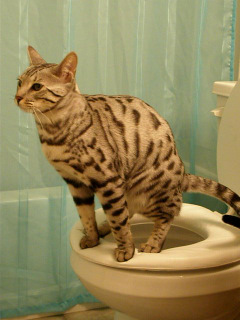Potential Risks of Flushing Cat Poop Down Your Toilet - Tips for Better Disposal
Potential Risks of Flushing Cat Poop Down Your Toilet - Tips for Better Disposal
Blog Article
Each person is bound to have their unique piece of advice in relation to Don’t flush cat feces down the toilet.

Intro
As pet cat owners, it's necessary to be mindful of how we take care of our feline good friends' waste. While it may seem convenient to purge cat poop down the toilet, this technique can have detrimental effects for both the setting and human wellness.
Environmental Impact
Purging feline poop introduces damaging pathogens and parasites right into the supply of water, posturing a considerable threat to water environments. These impurities can negatively influence marine life and compromise water high quality.
Health and wellness Risks
In addition to environmental concerns, flushing feline waste can additionally position health threats to human beings. Cat feces may include Toxoplasma gondii, a parasite that can cause toxoplasmosis-- a potentially severe disease, specifically for expectant ladies and people with damaged body immune systems.
Alternatives to Flushing
Thankfully, there are more secure and extra accountable means to dispose of cat poop. Take into consideration the complying with alternatives:
1. Scoop and Dispose in Trash
One of the most common method of throwing away pet cat poop is to scoop it right into an eco-friendly bag and throw it in the trash. Make sure to make use of a devoted trash scoop and take care of the waste immediately.
2. Usage Biodegradable Litter
Select biodegradable pet cat clutter made from materials such as corn or wheat. These litters are eco-friendly and can be safely disposed of in the trash.
3. Bury in the Yard
If you have a lawn, consider burying feline waste in a designated area far from veggie gardens and water resources. Be sure to dig deep enough to avoid contamination of groundwater.
4. Install a Pet Waste Disposal System
Invest in a pet garbage disposal system specifically made for pet cat waste. These systems utilize enzymes to break down the waste, reducing smell and ecological impact.
Conclusion
Responsible family pet possession expands beyond providing food and shelter-- it also includes correct waste administration. By refraining from purging cat poop down the bathroom and going with different disposal techniques, we can lessen our environmental footprint and shield human wellness.
Why Can’t I Flush Cat Poop?
It Spreads a Parasite
Cats are frequently infected with a parasite called toxoplasma gondii. The parasite causes an infection called toxoplasmosis. It is usually harmless to cats. The parasite only uses cat poop as a host for its eggs. Otherwise, the cat’s immune system usually keeps the infection at low enough levels to maintain its own health. But it does not stop the develop of eggs. These eggs are tiny and surprisingly tough. They may survive for a year before they begin to grow. But that’s the problem.
Our wastewater system is not designed to deal with toxoplasmosis eggs. Instead, most eggs will flush from your toilet into sewers and wastewater management plants. After the sewage is treated for many other harmful things in it, it is typically released into local rivers, lakes, or oceans. Here, the toxoplasmosis eggs can find new hosts, including starfish, crabs, otters, and many other wildlife. For many, this is a significant risk to their health. Toxoplasmosis can also end up infecting water sources that are important for agriculture, which means our deer, pigs, and sheep can get infected too.
Is There Risk to Humans?
There can be a risk to human life from flushing cat poop down the toilet. If you do so, the parasites from your cat’s poop can end up in shellfish, game animals, or livestock. If this meat is then served raw or undercooked, the people who eat it can get sick.
In fact, according to the CDC, 40 million people in the United States are infected with toxoplasma gondii. They get it from exposure to infected seafood, or from some kind of cat poop contamination, like drinking from a stream that is contaminated or touching anything that has come into contact with cat poop. That includes just cleaning a cat litter box.
Most people who get infected with these parasites will not develop any symptoms. However, for pregnant women or for those with compromised immune systems, the parasite can cause severe health problems.
How to Handle Cat Poop
The best way to handle cat poop is actually to clean the box more often. The eggs that the parasite sheds will not become active until one to five days after the cat poops. That means that if you clean daily, you’re much less likely to come into direct contact with infectious eggs.
That said, always dispose of cat poop in the garbage and not down the toilet. Wash your hands before and after you clean the litter box, and bring the bag of poop right outside to your garbage bins.
https://trenchlesssolutionsusa.com/why-cant-i-flush-cat-poop/

Do you enjoy more info about Can You Flush Cat Poo or Litter Down the Toilet?? Write a remark down the page. We would be interested to know your opinion about this write-up. We hope that you come back again soon. You should take the time to promote this blog posting if you appreciated it. I praise you for your time. Come back soon.
Book Service Report this page